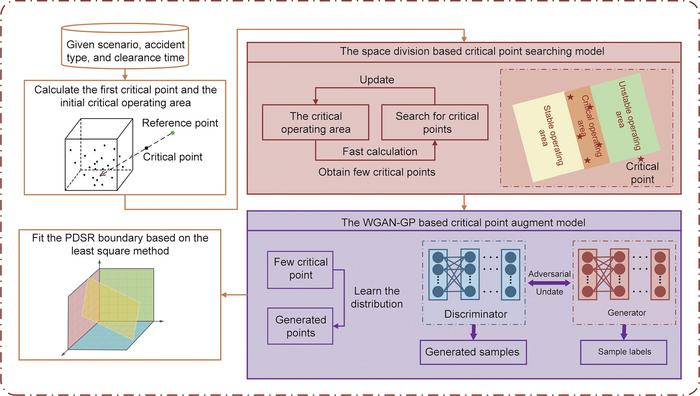Fast and accurate transient stability analysis is crucial to power system operation. With high penetration level of wind power resources, practical dynamic security region (PDSR) with hyper plane expression has outstanding advantages in situational awareness and series of optimization problems. The precondition of obtaining accurate PDSR boundary is to locate sufficient points around the boundary (critical points). Therefore, a research team led by Yanli Liu from Tianjin University, China, has developed a space division and Wasserstein generative adversarial network with gradient penalty (WGAN-GP) based fast generation method of PDSR boundary. The study, published in Engineering.

Credit: Yanli Liu et al.
Fast and accurate transient stability analysis is crucial to power system operation. With high penetration level of wind power resources, practical dynamic security region (PDSR) with hyper plane expression has outstanding advantages in situational awareness and series of optimization problems. The precondition of obtaining accurate PDSR boundary is to locate sufficient points around the boundary (critical points). Therefore, a research team led by Yanli Liu from Tianjin University, China, has developed a space division and Wasserstein generative adversarial network with gradient penalty (WGAN-GP) based fast generation method of PDSR boundary. The study, published in Engineering.
The integration of renewable energy sources into power systems has introduced significant uncertainty, posing substantial risks and challenges to system stability. Traditional methods for transient stability analysis, such as the point-by-point approach, have been time-consuming and often fall short in terms of accuracy and efficiency, especially with the growing complexity of modern power systems.
The research team’s innovative solution addresses these challenges head-on. By leveraging space division to narrow the search for critical points and employing the WGAN-GP model for data augmentation, the method significantly compresses the search space and accelerates the generation of critical points. This not only improves the confidence level of boundary fitting results but also enables a precise and efficient assessment of power system transient stability.
The paper begins by establishing the theoretical foundation for the method, highlighting the differential topological characteristics of the dynamic security region (DSR). It then introduces the space division technique, which divides the injection space into three areas to focus the search for critical points within the critical operating area where the PDSR boundary is located. The WGAN-GP model is subsequently used to generate a large number of critical points based on the data distribution learned from a small training set, allowing for the rapid fitting of the PDSR boundary using the least square method.
The proposed method was tested on the IEEE 39-bus system, with results demonstrating its remarkable accuracy and efficiency. The case study involved replacing traditional generators with wind turbines to simulate real-world scenarios, further validating the method’s practical applicability.
This breakthrough has profound implications for the power industry, offering a powerful tool for schedulers and engineers to maintain system stability amidst the growing integration of renewable energy sources. The method’s efficiency and accuracy could significantly reduce the risk of power system blackouts, ensuring a more reliable and secure power supply.
Looking ahead, the research team at Tianjin University is committed to further refining the method and exploring its application to a broader range of faults. With the potential to be integrated with deep learning technologies, the method could pave the way for even more sophisticated and responsive power system stability solutions.
The paper “Space Division and WGAN-GP Based Fast Generation Method of Practical Dynamic Security Region Boundary,” authored by Yanli Liu, Ruipeng Jia. Full text of the open access paper: https://doi.org/10.1016/j.eng.2024.05.017. For more information about the Engineering, follow us on X (https://twitter.com/EngineeringJrnl) & like us on Facebook (https://www.facebook.com/EngineeringJrnl).
Journal
Engineering
Article Title
Space Division and WGAN-GP Based Fast Generation Method of Practical Dynamic Security Region Boundary
Article Publication Date
19-Jun-2024



